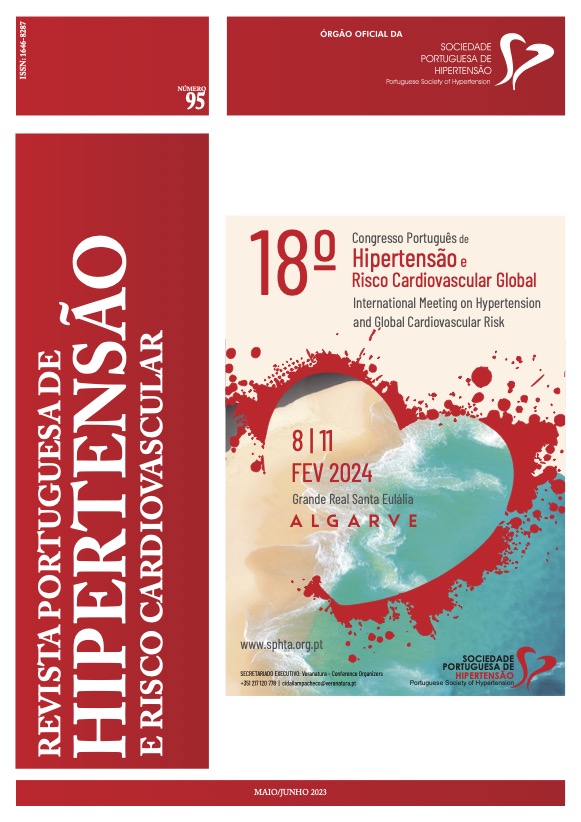EXISTE ASSOCIAÇÃO ENTRE O TRABALHO POR TURNOS COM HORÁRIO NOTURNO E O AUMENTO DE RISCO DE HIPERTENSÃO?
DOI:
https://doi.org/10.58043/rphrc.90Resumo
O trabalho por turnos é muitas vezes atrativo devido à maior flexibilidade de horários e melhores salários, contudo, traz alguns riscos e custos para a saúde dos trabalhadores. Esta revisão bibliográfica tem como objetivo verificar se existe associação entre o trabalho por turnos com trabalho noturno e o aumento do risco de hipertensão. Esta revisão da literatura foi realizada com recurso à base de dados da Pubmed e da Scielo, de artigos originais e de revisão, utilizando os termos “night shift”, “shift work” e “hypertension”. O trabalho por turnos incluindo o horário noturno altera a normal variação diurna da pressão arterial, reduzindo a descida noturna dos valores da pressão arterial. Embora esse efeito às vezes seja revertido, as mudanças para um perfil “non-dipper” podem, a longo prazo, aumentar o risco de hipertensão. Trabalhar à noite de forma rotativa tem maiores efeitos negativos na duração do sono do que os turnos noturnos fixos, e trabalhar em turnos noturnos é tipicamente mais perturbador para o sono do que os turnos da manhã ou da tarde. Assim, é possível concluir, com base em vários estudos, que existe associação entre trabalho com horários rotativos incluindo horário noturno e o aumento do risco de hipertensão.
Downloads
Referências
Manohar S, Thongprayoon C, Cheungpasitporn W, Mao MA, Herrmann SM. Associations of rotational shift work and night shift status with hypertension: a systematic review and meta-analysis. J Hypertens 2017 Oct;35(10):1929–37.
Rotenberg L, Silva-Costa A, Vasconcellos-Silva PR, Griep RH. Work schedule and self-reported hypertension - the potential beneficial role of on-shift naps for night workers. Chronobiol Int 2016;33(6):697–705.
Lu K,Chen J,Wang L,Wang C,Ding R,Wu S et al. Association of sleep duration, sleep quality and shiftwork schedule in relation to hypertension prevalence in chinese adult males: A cross-sectional survey. Int J Environ Res Public Health 2017 Feb;14(2):pii: E210.
Yeom JH, Sim CS, Lee J, Yun SH, Park SJ, Yoo CI et al. Effect of shift work on hypertension: cross sectional study. Ann Occup Environ Med 2017 Apr;29(11):11.
Alterman T, Luckhaupt SE, Dahlhamer JM, et al. Prevalence rates of work organization characteristics among workers in the US: data from the 2010 National Health Interview Survey. Am J Ind Med 2013; 56: 647– 659.
Parent-Thirion A, Biletta I, Cabrita J, et al. Eurofound, sixth european working conditions survey -overview report (2017 update). Publications Office of the European Union, Luxembourg Google Scholar. 2017.
Cheng P and Drake CL. Psychological impact of shift work. Curr. Sleep Med. Rep 2018; 4: 104–109.
Cappuccio FP, Miller MA. Sleep and cardio-metabolic disease. Curr Cardiol Rep. 2017;19(11):110.
Puttonen S, Härmä M, Hublin C. Shift work and cardiovascular disease - pathways from circadian stress to morbidity. Scand J Work Environ Health. 2010;36(2):96– 108.
Ohlander J.; Keskin MC., Stork J., Radon K.;Shift work and hypertension: Prevalence and analysis of disease pathways in a German car manufacturing company; Am J Ind Med. 2015 May;58(5):549-60.
Fu L, Lee CC. The circadian clock: pacemaker and tumour suppressor. Nat Rev Cancer. 2003;3(5):350–61. 12. Singh M., Jadhav H.; Melatonin: functions and ligands; Drug Discov Today. 2014 Sep;19(9):1410-8.
Gottlieb DJ, Redline S, Nieto FJ, Baldwin CM, Newman AB, Resnick HE, et al. Association of usual sleep duration with hypertension: the Sleep Heart Health Study. Sleep 2006; 29:1009–1014.
Akerstedt T. Shift work and disturbed sleep/ wakefulness. Sleep Med Rev 1998; 2:117–128
Pilcher JJ, Lambert BJ, Huffcutt AI. Differential effects of permanent and rotating shifts on self-report sleep
length: a meta-analytic review. Sleep 2000; 23:155–163. 16. Park J. et al.; Effect of night shift work on the control of hypertension and diabetes in workers taking medication; Annals of Occupational and Environmental Medicine. 2019 Oct 10;31: e27
Fujino Y, Isso H, Tamakoshi A, Inaba Y, Koizumi A, Kubo T et al. A Prospective Cohort Study of Shift Work and Risk of Ischemic Heart Disease in Japanese Male Workers. Am J Epidemiol. 2006;164:128-35.
Knutsson A, Bohhild H. Shiftwork and cardiovascular disease: review of disease mechanisms. Rev Environ Health. 2000;15:359-72.
Wang XS, Armstrong ME, Cairns BJ, Key TJ, Travis RC. Shift work and chronic disease: the epidemiological evidence. Occup Med (Lond). 2011;61:78-89.
Mosendane T, Mosendane T, Raal FJ. Shift work and its effects on the cardiovascular system. Cardiovasc J Afr. 2008;19:210-5.
Mark A, Weiler SW, Schroder M, Otto A, Jauch- Chara K, Groneberg DA et al. The impact of shift work induced chronic circadian disruption on IL-6 and TNF- immune responses. J Occup Med Toxicol. 2010;5:18.
Tafil-Klawe M, Klawe JJ, Zeomanczuk P, Szczepanska B, Sikorski W, Smietanowski M. Daily changes in cardiac and cardiovascular blood pressure components during breath holding episodes in obstructive sleep apnea patients after day-shift and night-shift work. J Physiol Pharmacol. 2007; 58:685-90.
Pimenta A. et al.; Night-shift work and cardiovascular risk among employees of a public university; 2012 Elsevier Editora Ltda.
Jong-Dar C., Yu-Cheng L. and Shu-Tin H.; Obesity and high blood pressure of 12-hours night shift female clean room workers; Chronobiology International, 27(2): 334-344 (2010)
Rahim A. et al.; The associations of shift work, sleep quality, and incidence of hypertension in Ontario adults: a population-based study; Canadian Journal of Cardiology 37 (2021) 513-518
Folkard S. Do permanent night workers show circadian adjustment? A review based on the endogenous melatonin rhythm. Chronobiol Int 2008; 25:215–224.
Downloads
Publicado
Como Citar
Edição
Secção
Licença
Direitos de Autor (c) 2023 Rui Cunha

Este trabalho encontra-se publicado com a Licença Internacional Creative Commons Atribuição 4.0.




